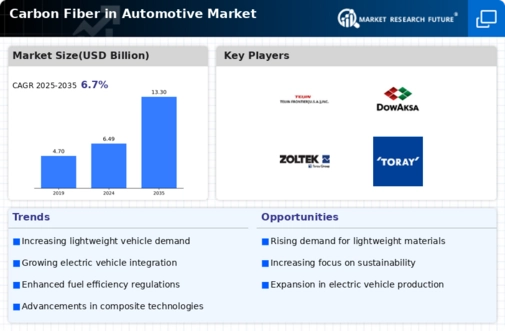Market Growth Projections
The Global Carbon Fiber in Automotive Market Industry is poised for substantial growth, with projections indicating a market size of 6.49 USD Billion in 2024 and an expected increase to 13.3 USD Billion by 2035. This growth trajectory suggests a compound annual growth rate of 6.71% from 2025 to 2035. Such figures highlight the increasing integration of carbon fiber in automotive applications, driven by factors such as lightweighting, regulatory compliance, and consumer preferences for high-performance vehicles. The market's expansion reflects a broader trend towards sustainable and efficient automotive solutions, positioning carbon fiber as a key material in the future of the industry.
Growing Electric Vehicle Market
The rise of electric vehicles (EVs) is significantly influencing the Global Carbon Fiber in Automotive Market Industry. As automakers strive to enhance the range and efficiency of EVs, the lightweight properties of carbon fiber become increasingly appealing. Carbon fiber components can help reduce the overall weight of electric vehicles, thereby improving battery performance and extending driving range. This trend is evident as major automotive manufacturers integrate carbon fiber into their EV designs, aligning with global sustainability goals. The market's growth trajectory is expected to be bolstered by the increasing adoption of EVs, further propelling the demand for carbon fiber solutions.
Increasing Demand for Lightweight Materials
The Global Carbon Fiber in Automotive Market Industry is experiencing a surge in demand for lightweight materials, driven by the automotive sector's focus on enhancing fuel efficiency and reducing emissions. Carbon fiber composites are significantly lighter than traditional materials such as steel and aluminum, which contributes to improved vehicle performance. In 2024, the market is projected to reach 6.49 USD Billion, reflecting a growing recognition of carbon fiber's advantages. As manufacturers increasingly adopt these materials to meet stringent regulatory standards, the market is expected to expand further, with projections indicating a potential growth to 13.3 USD Billion by 2035.
Regulatory Pressure for Emission Reductions
Regulatory frameworks aimed at reducing greenhouse gas emissions are exerting pressure on the automotive industry, thereby impacting the Global Carbon Fiber in Automotive Market Industry. Governments worldwide are implementing stringent emissions standards, compelling manufacturers to seek innovative solutions to comply with these regulations. Carbon fiber's lightweight characteristics enable automakers to produce vehicles that meet or exceed these standards while maintaining performance. As a result, the adoption of carbon fiber in automotive applications is likely to increase, as manufacturers prioritize compliance and sustainability. This trend is expected to contribute to the market's growth, with projections indicating a significant expansion in the coming years.
Technological Advancements in Manufacturing
Technological innovations in the production of carbon fiber are playing a crucial role in the Global Carbon Fiber in Automotive Market Industry. Advanced manufacturing techniques, such as automated fiber placement and resin transfer molding, enhance the efficiency and cost-effectiveness of carbon fiber components. These advancements not only reduce production costs but also improve the quality and consistency of the final products. As a result, automotive manufacturers are more inclined to incorporate carbon fiber into their designs, thereby driving market growth. The anticipated compound annual growth rate of 6.71% from 2025 to 2035 suggests a robust future for carbon fiber applications in the automotive sector.
Consumer Preference for High-Performance Vehicles
The Global Carbon Fiber in Automotive Market Industry is also influenced by shifting consumer preferences towards high-performance vehicles. As consumers increasingly demand vehicles that offer superior speed, handling, and efficiency, manufacturers are turning to carbon fiber as a solution. The material's strength-to-weight ratio allows for the design of vehicles that not only perform better but also provide enhanced safety features. This growing consumer interest in performance-oriented vehicles is likely to drive the demand for carbon fiber components, further solidifying its position in the automotive market. The anticipated growth in this sector aligns with the overall expansion of the carbon fiber market.
















Leave a Comment